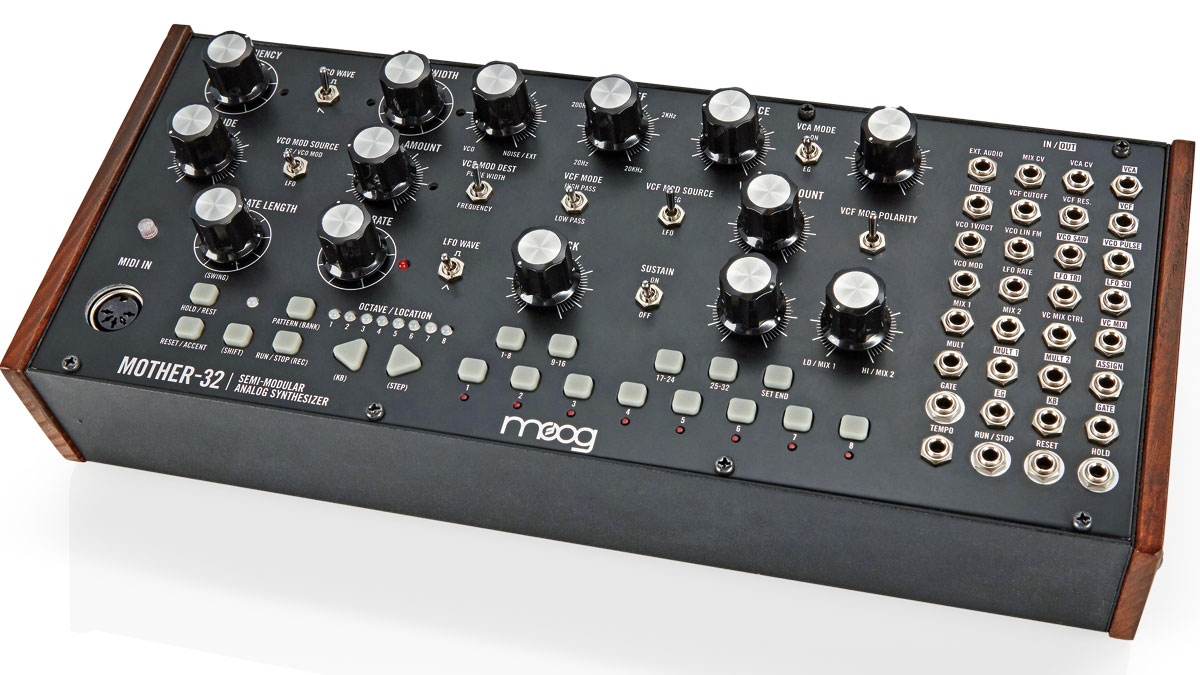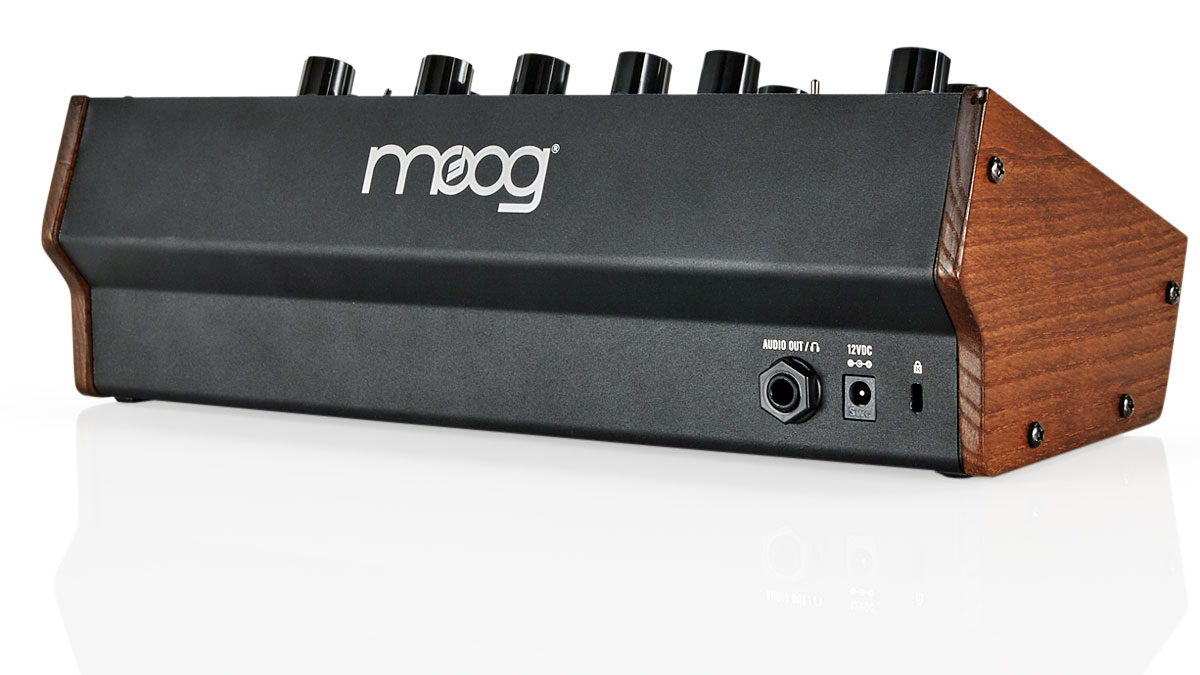MusicRadar Verdict
Moog delivers an exciting entry point into the world of patchable analogue synthesis.
Pros
- +
Good value.
Cons
- -
Very few.
MusicRadar's got your back

Moog Mother-32 Synthesizer

Moog Mother-32 Synthesizer
With the myriad of well-appointed hardware and software choices out there, who in their right mind is going to get excited about a single oscillator synth? This is, after all, the 21st century.
Turns out... loads of people. It may have a lot to do with the label, or the fact that it's semi-modular and Eurorack ready, or maybe because it's simply an affordable entry point into the realm of patchable analogue kit.
Whatever the reason, the arrival of the Moog Mother-32 caused a stir in advance of NAMM season 2016.
Fortified with a sequencer, MIDI connectivity, and a set of robust knobs and industrial toggle switches, Moog's latest instrument visually reeks of intrigue - particularly when it's racked with two other Mother-32 units to give users a taste of the ol' Keith Emerson vibe.
But until you've had a twiddle, it's hard to say whether some will see this as yet another gateway modular drug or just a nice-to-have synth that you could easily do without, all things considered. Let's press our space face close and have a look...
Mission control
When your gaze falls on the Mother-32's sturdy, compact build, you'll see a retro-industrial case whose entire footprint weighs in at just a little over 1.5kg. You've got the standard wooden Moog end cheeks hugging either side of the synth, MIDI jack on the front along with 1⁄4-inch audio out and 12V DC power jacks on the back side.
The wall wart power adaptor that the Mother-32 is delivered with has a universal switching plug that works with any 100 to 240V AC, 50/60Hz source. Since there's probably a good chance you've already seen photos of the Mother-32s nicely housed in a two or three-unit rack, keep in mind that you can't patch power from one unit to another, and will have to work out neatly routing the AC cables.
Want all the hottest music and gear news, reviews, deals, features and more, direct to your inbox? Sign up here.
The front panel can essentially be broken down into oscillator/sound modifier controls, the mini single octave keyboard, the 32-step sequencer, and the 32-point patchbay. If the synth doesn't seem to follow Moog's tradition of a visually logical layout, it is also not particularly fussy or hard to navigate after spending a bit of time with it.
"The playful sequencer, the solid analogue circuitry and its flexibility make it well worth the price."
Our sole voltage controlled oscillator (VCO) delivers two waveform flavours (determined via the Saw and Pulse toggle), and can be piloted with the Frequency, Pulse Width and VCO Mod Amount knobs. There's a Glide (portamento) control knob, while the Tempo/Gate Length control below that manages the speed of the sequencer.
The pot for the LFO Rate manages the Low Frequency Oscillator, but users get to choose whether it applies either a square or triangle wave to your signal. The Mix knob controls the blend of the VCO and the white noise (or external audio) outputs.
From there our signal heads into the voltage controlled filter (VCF) which has both a low-pass and high-pass mode (again via toggle switch) as well as Cutoff and Resonance knobs. Said filter can be modulated either by the LFO or the Envelope Generator (EG), with the amount of that modulation being controlled by... wait for it... the VCF Mod Amount control knob.
The EG has adjustable Attack and Decay controls and a toggle switch to determine if the Mother-32's Sustain remains on while a note is held or whether the Decay stage immediately follows the Attack stage.
Lift off
Straightaway we can honestly say that the sound is decidedly on point Moog-wise with the VCO. It's buzzy, rich and when you drop the octaves down it delivers a sound phat enough to satisfy.
Plus, you can always use the LFO as an additional sound source with some patching. The VCF, which is the classic Moog 24dB/octave ladder filter, upholds that fine sonic tradition, although it can lack some weight on the low-pass side once you start to pile the resonance on.
The patchbay, which could warrant an article of this size on its own, is thankfully off to the right side of the instrument where any tangle of cables that you come up with shouldn't interfere with any tweaking that's going on to your immediate left.
It took us a moment or two to work out, but the patch points that are labelled with white boxes are outputs, while those that aren't are inputs. Connections are made using 3.5mm cables and Moog does include a collection of 6-inch long ones with the instrument.
The connections feel uber secure across the board but to maximise patching in the multi-rack scenario we'd suggest getting longer leads to ensure you can with ease.
Similarly, small though the button keyboard may be, the overall spacing on the front panel works and you're never particularly cramped as you're tapping out melodies or programming the Mother-32's sequencer.
Speaking of which, those of you who remember our review of the Moog Sub Phatty from back in 2013, will surely recall the hubbub surrounding Shift Mode - an implementation designed to get increased functionality out of the synth through a combination of button mashing and keyboard switching.
The Mother-32's 64 recallable pattern sequencer also requires users to become familiar with a series of 'under the hood' style programming options that are well worth the amount of time it takes to master. Creating ratchets (repeats), pattern swings, along with slides/accents are all well documented in the manual, however. And those who are inclined to moan about this would do well to remember the cost savings this sort of design delivers.
Splash down
At the back of the booklet that comes with the Mother-32 are nine preset patch diagrams, which can get you on your way to making useful and familiar sounds. There are some blanks as well, and you can download additional templates from moogmusic.com on an as needed basis.
And while veteran tweakers and synthesists might rue a return to the era when these sort of crib notes were common, their grousing should be offset by the gradual shift away from convention and towards the genuine discovery that the Eurorack and revived modular revolution engender.
That said, the Mother-32 can be a tricky little beast unless you're just looking to it as a quick way to inject some analogue into your sound world. That is, of course, instantly achievable but, like most of the recent releases from Moog HQ, the real joy is in carving something distinct and personal out of the platform.
Several synth bods have noted that the filter and the LFO fail to track at 1V per octave without patching, and to some that will be annoying. We also found that, when chaining the VCA outs across multiple units, the synth didn't deliver as much gain as we'd hoped. Using the individual 1/4-inch outs was preferable.
First time semi-modular users can learn quite a bit from occupying the driver's seat of a Mother-32. And sure, having a rack of three at your disposal will speed your path to that satisfaction (as will grafting it to an existing Eurorack set-up), but there's still a great amount of sound to be conjured up with just the one.
The playful sequencer, the solid analogue circuitry, and the Mother-32's inherent flexibility make it well worth the price of entry. It's easily good Moog for your money.
Be warned though - buying one may lead you to purchasing another two, and then shelling out on a full Eurorack rig. It's a slippery slope...